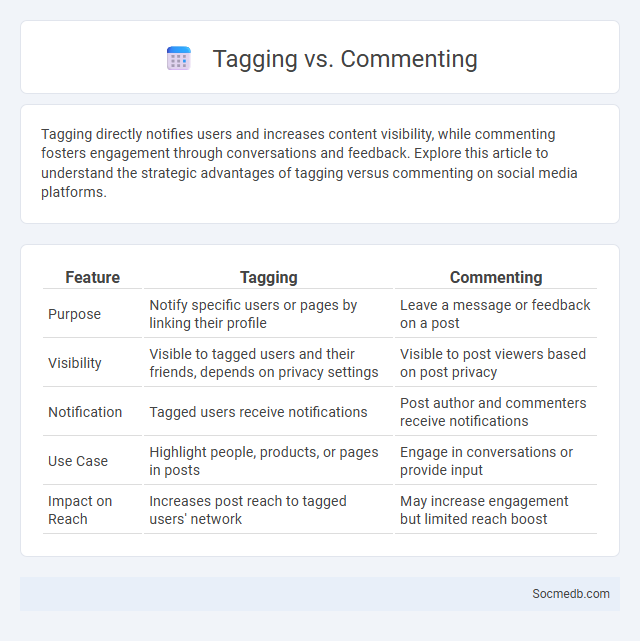
Photo illustration: Tagging vs Commenting
Tagging directly notifies users and increases content visibility, while commenting fosters engagement through conversations and feedback. Explore this article to understand the strategic advantages of tagging versus commenting on social media platforms.
Table of Comparison
| Feature | Tagging | Commenting |
|---|---|---|
| Purpose | Notify specific users or pages by linking their profile | Leave a message or feedback on a post |
| Visibility | Visible to tagged users and their friends, depends on privacy settings | Visible to post viewers based on post privacy |
| Notification | Tagged users receive notifications | Post author and commenters receive notifications |
| Use Case | Highlight people, products, or pages in posts | Engage in conversations or provide input |
| Impact on Reach | Increases post reach to tagged users' network | May increase engagement but limited reach boost |
Understanding Tagging: Definition and Purpose
Tagging on social media involves attaching keywords or user handles to posts, photos, or comments to link content with specific individuals or topics. This practice enhances content discoverability, enabling users to search and filter posts based on tags, which increases engagement and reaches targeted audiences. Effective tagging also fosters community interaction by notifying tagged users and encouraging participation within digital networks.
The Role of Commenting in Information Management
Commenting on social media platforms plays a crucial role in information management by facilitating real-time feedback and collaborative knowledge sharing. User-generated comments enhance content context, enable sentiment analysis, and support algorithmic filtering to improve content relevance and accuracy. Effective moderation of comments is essential for maintaining information quality and mitigating misinformation on platforms like Facebook, Twitter, and Instagram.
Tagging vs Commenting: Key Differences
Tagging on social media directly links a user to a post, increasing visibility and engagement by notifying the tagged individual and connecting their profile to the content. Commenting allows users to share opinions or feedback beneath a post without linking profiles, fostering conversations and interactions within the community. Both features enhance user interaction but serve distinct purposes: tagging targets specific individuals for attention, while commenting supports broader discussion.
Benefits of Tagging for Organization
Tagging in social media enhances content organization by categorizing posts, making information easily searchable and accessible for both users and brands. It improves engagement by connecting related content, which increases visibility through algorithmic recommendations. Efficient tagging supports targeted marketing strategies by allowing organizations to analyze trends and audience interests accurately.
Advantages of Commenting for Collaboration
Commenting on social media fosters real-time interaction, enhancing collaboration by enabling users to share diverse perspectives and provide instant feedback. This active engagement promotes community building, strengthens relationships, and accelerates problem-solving through collective input. Improved communication through comments leads to more efficient teamwork and knowledge exchange across various industries.
When to Use Tagging Over Commenting
Tagging is ideal when you want to directly notify or involve someone in a social media post, ensuring their immediate attention and engagement. Use tagging to attribute content, acknowledge collaborators, or encourage participation in conversations relevant to Your interests or network. Commenting suits general interactions without requiring direct notification, making it better for adding thoughts or questions on posts.
Best Practices for Effective Tagging
Effective tagging on social media significantly enhances content discoverability and engagement by using relevant, specific hashtags aligned with target audiences and trending topics. Employing a balanced mix of popular and niche tags increases visibility while avoiding over-tagging prevents spammy impressions. Consistent evaluation of tag performance and adapting strategies based on analytics ensures optimized reach and audience growth.
Optimizing Collaboration Through Comments
Optimizing collaboration through comments on social media enhances real-time feedback and promotes active engagement among team members, boosting productivity and idea-sharing. Utilizing features like threaded replies, mentions, and reaction emojis streamlines communication and ensures clarity in collaborative discussions. Implementing effective comment strategies can significantly improve project management and foster a transparent, inclusive digital workspace.
Integration of Tagging and Commenting Tools
Integration of tagging and commenting tools in social media platforms enhances user engagement by enabling precise content categorization and facilitating real-time interactions. Advanced tagging systems improve discoverability through semantic annotations, while rich commenting features support threaded discussions and multimedia responses. These integrated functionalities drive community building and increase content visibility, directly boosting platform activity and user retention.
Choosing the Right Method for Your Workflow
Selecting the optimal social media method involves analyzing your content goals, target audience behavior, and platform algorithms. Tools like scheduling apps, analytics dashboards, and content management systems enhance workflow efficiency and engagement tracking. Tailoring your approach according to real-time performance metrics ensures maximum reach and consistent brand voice across channels.
 socmedb.com
socmedb.com